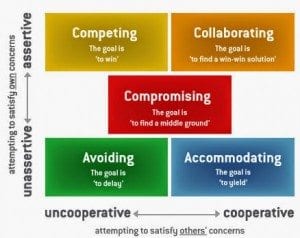Conflict is defined as a difference of wants, needs, or expectations. The workplace is filled with people who have differences of wants, needs, and expectations. Naturally, conflicts will occur. These conflicts can be an asset to the organization. If managed correctly, they may be opportunities for creativity, collaboration, and improvement.
5 Conflict Management Styles
So, how do you deal with and manage conflict? What’s your conflict management style? According to Thomas and Kilman, conflict is commonly managed with at least one of the following five strategies:
- Avoiding
- Accommodating
- Competing
- Compromising
- Collaborating
This chart represents the Thomas-Kilman conflict styles model. According to this model, a person’s behavior can be described along two dimensions: assertiveness and cooperativeness. Assertiveness is the extent to which one attempts to satisfy his or her own concerns. Cooperativeness is the extent to which one attempts to satisfy the other person’s concerns. These two dimensions of behavior can be used to define the five specific styles of dealing with conflict.
Avoiding
This approach to dealing with conflict is to avoid it entirely. People who use this style tend to accept decisions without question, avoid confrontation, and delegate difficult decisions and tasks. Avoiding is a passive approach that is typically not effective, but it does have its uses.
This style is appropriate when:
- The issue is trivial
- The conflict will resolve itself on its own soon
This style is not appropriate when:
- The issue is important to you or those close to you (such as your team)
- The conflict will continue or get worse without attention
Accommodating
The accommodating style is one of the most passive conflict resolution styles. With this style, one of the parties in conflict gives up what they want so that the other party can have what they want. In general, this style is not very effective, but it is appropriate in certain scenarios.
This style is appropriate when:
- Maintaining the relationship is more important than winning
- The issue at hand is very important to the other person but is not important to you
This style is not appropriate when:
- The issue is important to you
- Accommodating will not permanently solve the problem
Competing
With a competitive approach, the person in conflict takes a firm stand. They compete with the other party for power, and they typically win (unless they’re up against someone else who is competing!) This style is often seen as aggressive, and can be the cause of other people in the conflict feeling injured or stepped on.
This style is appropriate when:
- A decision needs to be made quickly (i.e., emergencies)
- An unpopular decision needs to be made
- Someone is trying to take advantage of a situation
This style is not appropriate when:
- People are feeling sensitive about the conflict
- The situation is not urgent
Compromising
With the compromising approach, each person in the conflict gives up something that contributes towards the conflict resolution.
This style is appropriate when:
- A decision needs to be made sooner rather than later (meaning the situation is important but not urgent)
- Resolving the conflict is more important than having each individual “win”
- Power between people in the conflict is equal
This style is not appropriate when:
- A wide variety of important needs must be met
- The situation is extremely urgent
Collaboration
With the collaborating approach, the parties work together to develop a win-win solution. This approach promotes assertiveness (rather than aggressiveness or passiveness).
This style is appropriate when:
- The situation is not urgent
- An important decision needs to be made
- The conflict involves a large number of people or people across different teams
- Previous conflict resolution attempts have failed
This style is not appropriate when:
- A decision needs to be made urgently
- The matter is trivial to all involved
Self-awareness of your own style and an understanding the different conflict strategies is helpful when you find yourself engaged in conflict. When combined with a simple conflict resolution framework, you will be well on your way to improving relationships and getting things done.





